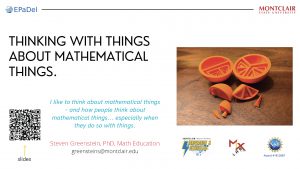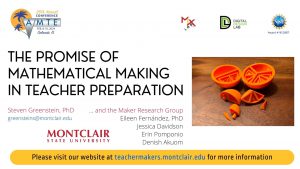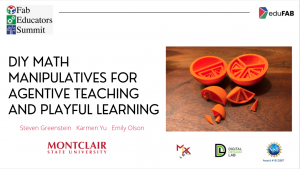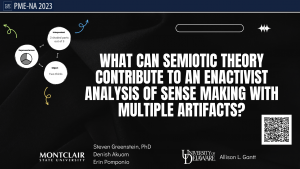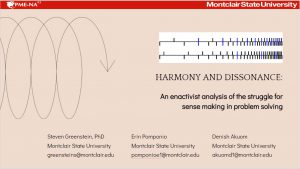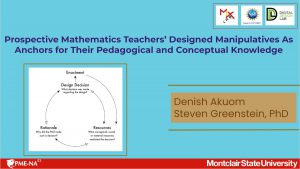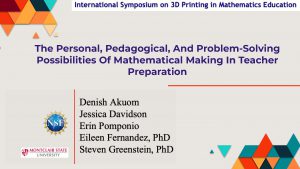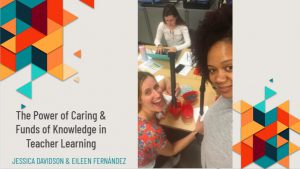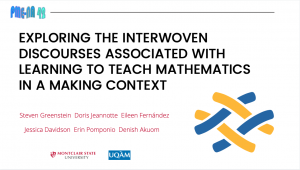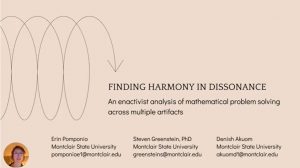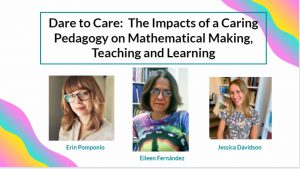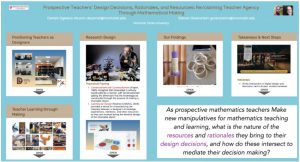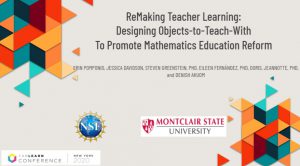RESEARCH FINDINGS
This work is addressing the following research questions. Brief responses are provided.
The Making experience has provided opportunities for PMTs to embed their developing knowledge into the design of their tools, influencing not only their experience as a Maker, but also the depth of their mathematical understanding. Moreover, it also elicited distinct facets of content and pedagogical knowledge as well as their integration during authentic teacher learning moments, which supported practices like reasoning mathematically or persisting through the often messy process of teaching and learning mathematics.
The curricular module serves as a transitioning vehicle for PMTs between their teacher education setting and actual classrooms, supporting a diverse and multifaceted array of possibilities for them to draw from in their future teaching. In addition, by enacting pedagogies of care in conjunction with mathematical Making experiences, we offered our PMTs a shift in mindset that celebrated and re-centered marginalized individuals within the mathematical learning and Making communities.
The Making experience has afforded PMTs the opportunity to engage the complexities of navigating mathematical problem-solving tasks through multiple representations of ideas, emerging with deeper understandings of those ideas and a realization of the power of exploratory, tool-mediated mathematical activity on teachers and students alike. Our analysis of the nature of our PMTs’ design activity has revealed the diversity of design decisions, rationales, and mediating resources such an experience entails, as well as the importance of viewing learning as a situated process of a teacher becoming.
We’ve been exploring how PMTs learn to teach mathematics through their engagement in a pedagogically informative Making experience, and the roles that their identities played in their design decisions, mathematical activity, and pedagogy. Using a commognitive perspective, we examined our PMTs’ learning by observing changes in their discourse surrounding mathematics, identity, pedagogy, and design. We found that the Making experience was an effective venue for provoking all four of these discourses and that these discourses are actually intertwined. This finding further illustrates that one’s identity is as central to learning to teach mathematics as is their learning of mathematics, pedagogy, and design. More broadly, through the reflective and participatory creative processes associated with the Maker experience and the inquiry-oriented learning environment the teacher educators cultivated in the course, we found that the class provided the PMTs with an opportunity to remake personal relationships with mathematics and mathematics teaching rooted in exploration and creativity, and imbued with dynamic and deep understandings of mathematical ideas.
PRESENTATIONS
This work is being disseminated through the following presentations.
As mathy people, we like to think about mathematical things. As a math educator, I like to think about how things shape our thinking about mathematical things. Things like physical manipulatives – tangible objects with pedagogical purposes – have a long history in math education. Recent research is contributing to the discussion by affirming that our thinking is not confined to the head. Rather, it is fully embodied. Even further, it’s extended through our interactions with material things. As the theory goes, the knowledge we have arises from our engagement with the full sensations of these embodied and extended experiences. In a very real sense, making sense is that which we make of our senses. In this talk, I express some of these ideas through activities that invite the audience to make sense of mathematical ideas through their engagement with original manipulatives designed by future elementary teachers as part of their mathematics teacher preparation coursework. These experiences aim to demonstrate that manipulatives can provide the experiential context for activities essential to students’ learning of mathematics – and at every level of mathematics. [Presentation]
This workshop presentation was given at the 2024 meeting of the Association of Mathematics Teacher Educators (AMTE). We shared vignettes of research on the Mathematical Making Experience and findings from those projects that lend credence to the claim that positioning future teachers as designers innovating at this intersection can nurture their identities as teachers of mathematics and move them along trajectories of a “teacher becoming.” Accordingly, we shared the promise of this design experience for developing teacher knowledge and for enabling the “well-prepared, beginning teacher of mathematics” (AMTE, 2017, p. 6) to enact it through effective pedagogical practices that support their students’ mathematical learning (Standards P.2 & P.3). [Presentation]
We designed a Mathematical Making Experience that has prospective elementary teachers exploring at the intersection of content, pedagogy, and design as they make an original math manipulative to be used in teaching. In this Lightning Talk for the eduFAB annual conference, we present the Making experience, explain the rationale for its use in teacher preparation, and share some of its outcomes. We conclude the talk with a reflection on the benefits of “responsive design” as a medium for teachers’ curricular agency, mathematical creativity, and pedagogical play. [Presentation]
Extending our prior work, which took an enactivist approach and revealed the dynamics of embodied interactions fundamental to understanding fraction division, we now employ a semiotic lens to illuminate how learners make personal meanings from their engagement with multiple artifacts and translate them into more generalized mathematical meanings. We do so by taking a semiotic approach to tracking the emergent phenomenon of one learner’s meaning making as it arises from the complex interplay of signs. We rely on our findings to argue that semiotic theory can be used as a resource to complement and enhance an enactive analysis of the unfolding of sense making with multiple artifacts. [Presentation]
- We explored the problem solving of two learners as they aimed to make sense of fraction division by coordinating meanings across two artifacts, one being a physical manipulative and the other a written expression of the standard algorithm. In addressing the question, “How do learners make sense of and coordinate meanings across multiple representations of mathematical ideas?” we took an enactivist perspective and used tools of semiotics to analyze the ways they navigated the dissonance that arose as they sought to achieve harmony in meanings across multiple representations of ideas. [Presentation]
- In this presentation, we share what we’ve learned about how the designing and testing of 3-D printed manipulatives by prospective elementary mathematics teachers (PMTs) acts as a creative process that reveals the potential benefits of mathematical Making in teacher learning. [Presentation]
- In this presentation, we share what we’ve learned about how the designing and testing of 3-D printed manipulatives by prospective elementary mathematics teachers (PMTs) acts as a creative process that reveals the potential benefits of mathematical Making in teacher learning. [Presentation]
- We demonstrate that the Making experience afforded opportunities for enacting a caring pedagogy that elicited PMTs’ funds-of-knowledge, and that this approach provided a transitioning vehicle between the teacher education setting and actual classrooms. [Presentation]
- We share our findings that Making is an effective venue for provoking mathematizing, identifying, pedagogy and designing discourses; revealing their intertwined nature; and illustrating that one’s identity is as central to learning to teach mathematics as is their learning of mathematics, pedagogy, and design. [Presentation]
- This work explores the emergent nature of mathematical activity mediated by multiple artifacts. Findings reveal the complexity of mediated engagement and have implications for the practice of learning mathematics through multiple representations. [Presentation]
- Guided by the question, “How does enacting a caring pedagogy during a Making-centered experience impact and broaden opportunities for meaningful mathematics learning?” we suggest a pedagogy of caring, sharing, and Making as one way to celebrate and re-center individuals who are often marginalized from meaningful learning in spaces for Making. [Presentation]
- This paper shares findings that convey the diversity of design decisions, rationales, and mediating resources that entailed PMTs’ mathematical Making. [Presentation]
- We use project data and personal narratives to make a case for the transformative power that design and Making have within the space of mathematics learning and teaching. [Presentation]
PUBLICATIONS
The work is also being disseminated through these publications.
This work seeks to contribute to our collective understanding of the dynamics of in-the-moment, emergent mathematical sense making. We undertook an enactivist analysis, which revealed the embodied interactions that were fundamental to one learner’s emerging understanding of fraction division through mediated engagement with multiple artifacts. However, that analysis could neither track nor explain the structural drift of this learner’s initially enacted meanings as they evolved toward more generalized mathematical meanings. So as a next step in the analysis, we used tools of semiotics to elucidate the evolution of these meanings in terms of a complex interplay of signs. Our findings demonstrate the affordances of combining (Prediger, Bikner-Ahsbahs, et al., 2008) the theoretical perspectives of enactivism and semiotics and serve as the basis upon which we argue that tools of semiotics can be used as a resource to enhance an enactivist analysis of the unfolding of sense making with multiple artifacts. We conclude the piece by articulating this methodological contribution and follow with the practical implications of our findings for teaching as they relate to meaning making with multiple artifacts.
The process of becoming a mathematics teacher is one that entails the development of an integrated base of teacher knowledge. A considerable body of research has been undertaken to identify the knowledge that is essential to effective mathematics teaching and to determine how it could be developed. In this chapter, we aim to make a contribution to this body of research by accounting for the essential role of the knower’s situated and agentive interactions with the social, material, and conceptual artifacts that mediate such knowledge development. We do so through a revelatory case study of one prospective teacher named “Moira” as she participates in a constructionist Making experience within a specialized mathematics content course for future elementary teachers. Using both cultural-historical activity theory and figured worlds perspectives, we took a novel approach to the analysis of a range of interactions that mediated Moira’s design activity. This analysis of three “moments of becoming” on Moira’s trajectory demonstrates the methodological value of this analytic approach by revealing the blended nature of knowledge and identity that constitutes learning in and through collective social practice. In addition, these findings establish the theoretical value of framing Making as mediated learning and offer empirical evidence of the formative power of the Making experience not only for the development of Moira’s mathematical, pedagogical, and design knowledge, but also for her identity as a mathematics teacher. We conclude the chapter by considering the implications of these findings for teacher preparation coursework and proposing future directions for research. [Link]
- Access to maker technologies has catalyzed and amplified the possibilities for creating physical materials that are responsive to the needs of students. Opportunities for design and fabrication of original mathematics manipulatives have been incorporated into the teacher education program at Montclair State University. Participating preservice elementary teachers design and make original mathematics manipulatives. Three case studies examine ways in which this process enhances students’ mathematical reasoning, sense-making, and understanding. [Link]
- In this chapter, we share vignettes of several research projects that address the research question that broadly frames this work: What are the potential benefits of a Making experience within mathematics teacher preparation? These vignettes provide snapshots of this body of work. [Link]
- Covariational reasoning and the creation and interpretation of graphs of covariational situations are important skills in math and science. Unfortunately, research shows that students often struggle to make meaningful connections between graphs and the covariational situations they represent. Educational activities designed to help students overcome this struggle tend to use either student-generated or automatically-generated graphs, and have students either act out covariational situations or more passively observe them. In this paper, we present the design of a tool and task that enabled two students to simultaneously embody both the creation of a graph and the covariational actions that the graph represents. Through a process of collaborative instrumentation, the students made meaningful connections between their motions and the embodied traces they created as they reasoned about the covarying quantities of height and time [PDF]
- In this paper, we share research that explores the potential benefits of a novel Making experience within mathematics teacher preparation that we hypothesized would inform the pedagogical and curricular thinking of prospective teachers of elementary mathematics (PMTs). That experience had PMTs exploring at the intersection of content, pedagogy, and design to digitally design, 3D print, and share an original manipulative with a child to promote their mathematical thinking. We share several vignettes of our research that aim to discern some of the potential benefits the experience might offer PMTs. These take a variety of theoretical and methodological approaches at the intersections of teacher knowledge, identity, pedagogy, and design. Implications of our findings for teacher preparation and professional learning are provided throughout the paper and in its conclusion [PDF]
- This paper reports on research that examines connections between the pedagogical/conceptual knowledge that prospective teachers embed in the designs of original manipulatives and how those designs mediate the pedagogical moves they make in teaching situations. We share findings from the analysis of prospective teachers’ design activity that conveys (1) the diversity of design decisions, rationales, and mediating resources that it entailed, and (2) how the designed manipulative act as anchors for their conceptual/pedagogical moves. The implications of these findings for teacher preparation and professional learning are considered. [LINK]
- This paper reports on research that examines connections between the pedagogical/conceptual knowledge that prospective teachers embed in the designs of original manipulatives and how those designs mediate the pedagogical moves they make in teaching situations. [PDF]
- We explored the problem solving of two learners as they aimed to make sense of fraction division by coordinating meanings across two artifacts, one being a physical manipulative and the other a written expression of the standard algorithm. We took an enactivist perspective and used tools of semiotics to analyze the ways they navigated the dissonance that arose as they sought to achieve harmony in meanings across multiple representations of ideas. [PDF]
- We demonstrate that the Making experience afforded opportunities for enacting a caring pedagogy that elicited PMTs’ funds-of-knowledge, and that this approach provided a transitioning vehicle between the teacher education setting and actual classrooms. [PDF]
- We share our findings that Making is an effective venue for provoking mathematizing, identifying, pedagogy and designing discourses; revealing their intertwined nature; and illustrating that one’s identity is as central to learning to teach mathematics as is their learning of mathematics, pedagogy, and design. [PDF]
- This work explores the emergent nature of mathematical activity mediated by multiple artifacts. Findings reveal the complexity of mediated engagement and have implications for the practice of learning mathematics through multiple representations. [PDF]
- Guided by the question, “How does enacting a caring pedagogy during a Making-centered experience impact and broaden opportunities for meaningful mathematics learning?” we suggest a pedagogy of caring, sharing, and Making as one way to celebrate and re-center individuals who are often marginalized from meaningful learning in spaces for Making. [PDF]
- This paper shares findings that convey the diversity of design decisions, rationales, and mediating resources that entailed PMTs’ mathematical Making. [PDF]
- We use project data and personal narratives to make a case for the transformative power that design and Making have within the space of mathematics learning and teaching. [PDF]

